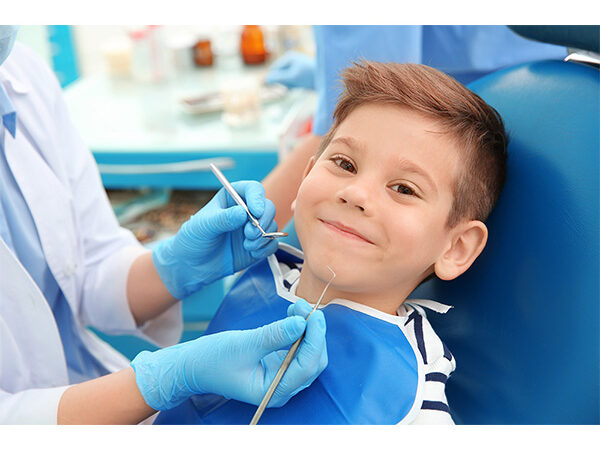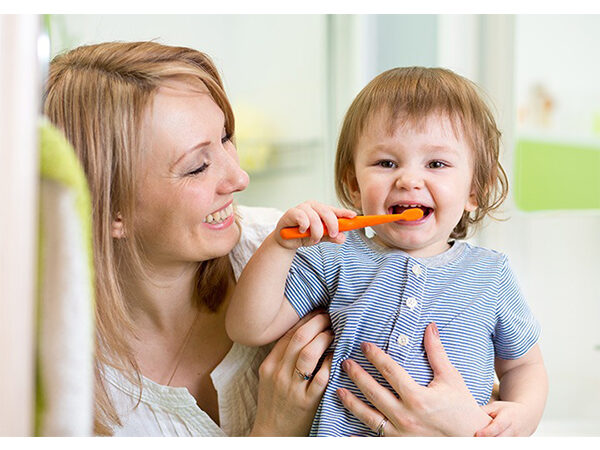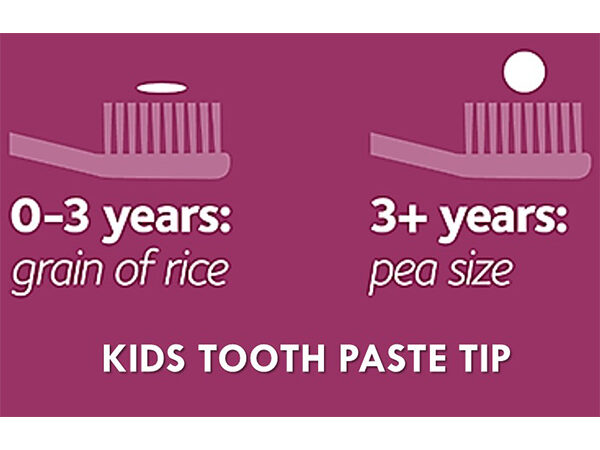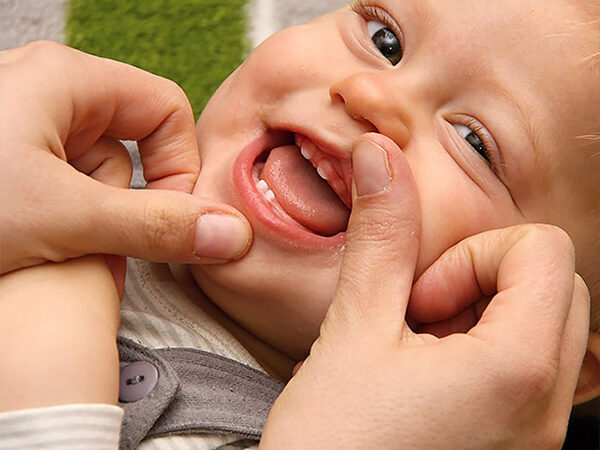Healthy smile for every child
Child Dentistry
Child Dentistry is involves the oral health of children from infancy through the teen years. Life Care Dental Clinic in Mysore has the experience and qualifications to care for children teeth, gums, and mouth throughout the various stages of childhood.
Never neglect primary teeth when they have decays or cavities, thinking they don not need treatment as they will be replaced by the permanent teeth at a later stage. A Primary tooth infection can also damage the permanent new tooth during its growth inside the jaw, before it erupts on the arch. In this event the permanent tooth often develops already damaged or with defects.
When should I take my child to the dentist?

When will my child’s teeth appear?
Milk (baby) teeth usually start to appear when your child is around 6 months old. All 20 baby teeth should appear by the age of 30 months. By age 6 or 7 years, they start to lose their first set of primary teeth, which are replaced by permanent teeth.
It is usually the lower front milk teeth that are lost first, followed by the upper front teeth shortly after. All permanent teeth should be in place by the age of 12, except the wisdom teeth, that may appear any time between 18 and 23 years of age.
What happens on your baby’s first visit?
The first appointment will generally just involve an examination of the teeth, gums, and tongue. Subsequent appointments may involve teeth cleaning and fluoride treatment depending on the need. In circumstances where child has developed cavities and tooth decay, dentist will inform you and advice on the appropriate treatment.
What are the different treatment needed for the children?
 What are pit and fissure sealants?
What are pit and fissure sealants?
Pit and Fissure Sealants are a safe and painless way of protecting your teeth from tooth decay. A sealant is a protective plastic coating, that are used to smooth out grooves on the back molar and premolar teeth. The sealants form a hard shield that keeps food and bacteria from getting into the tiny grooves in the teeth and causing decay.
Why sealants are needed?
Brushing and flossing alone cannot always get into all the pits in the teeth and the hard-to-reach areas in the mouth. Inadequate cleaning can cause food particles and plaque to accumulate and this can lead to tooth decay. Sealants after it hardens, prevents food and plaque from getting caught and stuck within the depressions and grooves of the teeth.
What is involved?
The process is usually quick and straightforward, taking only a few minutes for each tooth. The tooth is thoroughly cleaned, prepared with a special solution, and dried. The liquid sealant is then applied into the grooves which is then hardened with a special intensity light.
How do pit and fissure sealants work?
The sealant forms a smooth, protective barrier by covering all the little grooves and dips in the surface of the tooth. Dental decay easily starts in these grooves if they are not sealed
Which teeth should be sealed?
Sealants are only applied to the biting surfaces of the back teeth - the molars and premolars. These are the teeth that have ‘pits' (small hollows) and ‘fissures' (grooves) on their biting surfaces. Your dentist will tell you which teeth should be sealed after examining them, and also check whether the fissures are deep enough for sealing or not. Some teeth naturally have deep grooves which will need to be sealed; others have shallow ones which will not need sealing.
When should the child go for pit and fissure sealents?
Sealants are often applied as soon as the first permanent teeth start to come through. This is usually between 6 and 7 years of age. The rest are usually sealed as soon as they appear which can be any time between 11 and 14 years of age.
Though sealants can protect the teeth for years, they may need to be examined for chipping, wearing or breaking. They may be fixed and replaced by your dentist as necessary.
Pulpectomy is indicated when there is spontaneous tooth pain due to decay in the milk tooth. The pulp tissue (nerve) of the primary tooth will be necrotic. The infected pulp tissue is removed and the primary tooth is protected as it must be maintained in the dental arch as long as possible. This is done to keep the arch integrity and to protect the future permanent teeth.
In children Dental X-ray or Digital X- ray can show any teeth that haven't come through yet and development and number of teeth inside the mouth. Our Digital x-rays produce a significantly lower level (80-90%) of radiation compared to traditional dental x-rays. X-rays are taken only if it is absolutely necessary.
How should I clean my child’s teeth?


Cleaning your child’s teeth should be part of their daily hygiene routine. You may find it easier to stand or sit behind your child, cradling their chin in your hand so you can reach their top and bottom teeth more easily.
The recommended oral hygiene tips for children:
- It is important to supervise your child’s brushing until they are at least seven.
- Brushing: Brushing should be done at least 2 times a day at least for 2 minutes each time.
- Spitting: Your child should be encouraged to spit the toothpaste out because swallowing too much fluoride at a young age can affect the development of the teeth.
- Children should not be given to eat or drink anything after brushing at night except water.
- Ages 0-3: Use a small hand towel or baby toothbrush to clean the teeth twice a day without toothpaste. Do not give your baby or toddler a bottle to sleep with
- Ages 4-6: Use a children’s toothbrush with a small head and soft bristles in small, circular movements and try to concentrate on one section at a time. Use a low strength fluoride tooth paste. Supervise your child’s brushing at night
- Ages 7-12: Use a children’s toothbrush and you can start using adult toothpaste. Teach and practice flossing once or twice a week
- Don’t forget to brush gently behind the teeth and onto the gums.
What could cause my child to have toothache?
Tooth decay: Tooth decay is one of the main causes for toothache in children. This is due to too much sugar, too often, in the diet.
Teething: Teething or appearance of first teeth in children starts at around 6 months, and it can continue when the adult teeth start to appear.
How can I prevent tooth decay in children?
The main cause of tooth decay is not the amount of sugar or acid in the diet, but how often it is eaten or drunk. The more often your child has sugary or acidic foods or drinks, the more likely they are to have decay. So it is important to have sugary and acidic foods just at mealtimes.
Don’t give them drinks containing sugars, including fruit juices, between meals. Give them water or milk instead. For babies, don’t add sugar to their drinks, or to foods when you introduce them to solids.
Thorough brushing with a fluoride toothpaste just before your child goes to bed and at least one other time (morning) during the day, will help to prevent tooth decay.
What is Teething in children?
Teething is the process in which your infant’s first teeth appear by emerging through the gums, typically arriving in pairs. It starts at around 6 months, and it can continue when the adult teeth start to appear.
Signs and symptoms of teething:
- Babies may have a high temperature.
- Swollen, bulging gums.
- A tooth visible below the gum.
- Trouble sleeping.
- Trying to bite, chew, and suck on everything.
- Rubbing the face.
- Rejecting food.
- Grabbing the ears.

How do I manage my baby’s Teething pain?
Keep that area cold – Refrigerate a pacifier or teether before giving it to child or serve up a bit of chilled fruit
Apply pressure on the gums as it can distract your child’s brain from the sensation of teething pain. If keeping it cold is rejected, have your child chew on a teether at room temperature,
Use Topical Medications such as numbing gels and creams to rub on your baby’s gums available with dentist’s recommendation.
Use pain relief medicine advised by your dentist.
We at Life Care Dental Clinic Mysore, know that providing oral healthcare to children requires a special, gentle touch. We love helping kids get healthy teeth, and we know how to set them at ease and keep dentist appointments fun and friendly so they don’t have to grow up with a fear of the dentist. If you are looking for specialist dentist in Mysore for your child’s teeth problem, you can contact us or book an appointment with us.
FAQ's on Child Dentistry
An early start to dental visits also helps the dentist and child begin to form a relationship based on trust. One of the saddest things we sometimes encounter is when a child’s first visit to the dentist is motivated by toothache or dental trauma.
It is difficult for a child suffering from pain or trauma to separate this from the treatment environment if they have not had positive non-threatening experiences beforehand

